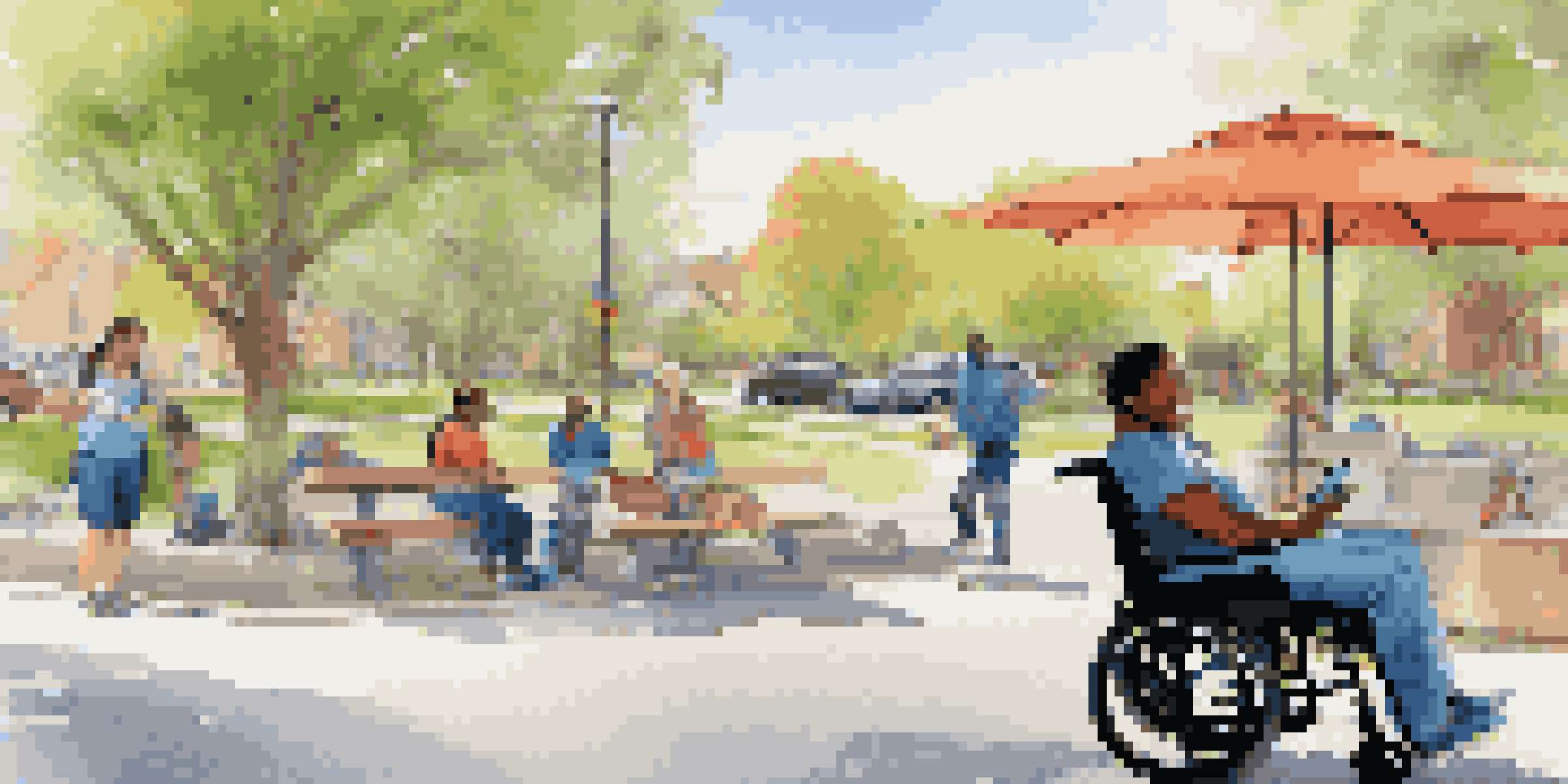Crowdsourced Mobility Solutions for Disabled Users

Understanding Crowdsourced Mobility Solutions
Crowdsourced mobility solutions leverage technology and community involvement to provide transport options. These solutions are particularly beneficial for disabled users who often face barriers in accessing traditional transport systems. By utilizing apps and platforms, communities can offer rides or assistance in real-time, making mobility more inclusive.
The greatest disability is not a physical one; it's the inability to connect with others and share our journeys.
Imagine a neighborhood where someone needing a ride can simply use an app to connect with a local volunteer. This not only fosters community spirit but also ensures that those with disabilities can travel with greater ease and independence. The power of the crowd lies in its ability to respond quickly to individual needs, creating a flexible transport network.
Crowdsourced mobility isn't just about getting from point A to point B; it's about creating a supportive ecosystem. This approach can significantly improve the quality of life for disabled individuals, allowing them to participate more fully in their communities and access essential services.
Benefits of Crowdsourced Mobility for Disabled Users
One of the most significant benefits of crowdsourced mobility is increased accessibility. Traditional transport options may not always cater to the needs of disabled users, but crowdsourcing allows for tailored solutions that can accommodate various mobility requirements. This level of customization makes travel less daunting and more feasible.

Additionally, these solutions often come at a lower cost compared to conventional transport services. Users can find affordable rides or assistance through community-driven platforms, reducing financial stress. This affordability opens up new opportunities for disabled individuals to engage in work, social activities, and more.
Moreover, the social aspect of crowdsourced mobility cannot be overlooked. It connects people, breaking down barriers and fostering relationships between drivers and riders. This interaction enriches the community and helps to cultivate understanding and empathy toward the challenges faced by disabled users.
Technology Driving Crowdsourced Mobility Solutions
Modern technology plays a pivotal role in the success of crowdsourced mobility solutions. Mobile apps and GPS technology enable seamless connections between users and drivers, ensuring that assistance is just a tap away. This tech integration simplifies the user experience, making it accessible even to those who may not be tech-savvy.
Mobility is not just about moving from one place to another; it's about the freedom to participate in life.
For instance, many platforms now include features specifically designed for disabled users, such as vehicle accessibility information. This ensures that riders can choose a vehicle that meets their specific needs, whether it's a wheelchair-accessible van or a car with extra space. Such thoughtful design enhances user confidence in utilizing these services.
Furthermore, the use of data analytics helps improve these platforms continually. By analyzing user behavior and feedback, companies can refine their services, ensuring they remain relevant and effective for disabled users. This commitment to improvement is crucial for maintaining trust and satisfaction within the community.
Challenges Faced by Crowdsourced Mobility Solutions
Despite their advantages, crowdsourced mobility solutions do face challenges. One significant issue is the variability in service quality, as volunteer drivers may have different levels of training or experience. This inconsistency can create uncertainty for disabled users who rely on dependable transport.
Another challenge is the need for widespread awareness and acceptance within communities. Not everyone may be familiar with these services, which can limit participation. Community outreach and education are essential to ensure that both drivers and users understand how to engage with these solutions effectively.
Finally, regulatory hurdles can complicate the implementation of these services. Different regions may have varying laws governing rideshare and volunteer transport, which can impact the growth and sustainability of crowdsourced mobility solutions. Addressing these legal aspects is crucial for fostering an environment where these solutions can thrive.
Successful Examples of Crowdsourced Mobility Programs
Several successful programs illustrate the potential of crowdsourced mobility for disabled users. For example, some cities have implemented volunteer driver programs specifically aimed at assisting those with mobility challenges. These initiatives have seen positive outcomes, with many users reporting improved access to essential services and social opportunities.
Another example comes from platforms that connect disabled riders with drivers trained to assist them. These services prioritize safety and comfort, ensuring that users feel secure during their travels. By focusing on user needs, these programs have built strong reputations and fostered trust within the community.
Such success stories highlight the importance of community involvement and the willingness to innovate. When people come together to address mobility challenges, the results can be transformative, proving that crowdsourced solutions can indeed make a difference in the lives of disabled individuals.
The Role of Advocacy in Crowdsourced Mobility
Advocacy plays a crucial role in the development and expansion of crowdsourced mobility solutions for disabled users. Organizations dedicated to disability rights often push for policies that support inclusive transport options. Their efforts can lead to increased funding and resources for programs aimed at improving accessibility.
Moreover, advocacy groups can help raise awareness about the unique mobility challenges faced by disabled individuals. By sharing personal stories and experiences, they can humanize the issue and encourage community participation in crowdsourced initiatives. This connection is essential for fostering empathy and understanding.
Ultimately, advocacy efforts can drive change at both local and national levels. By pushing for supportive legislation and public awareness, advocates can help create a more inclusive environment where crowdsourced mobility solutions can flourish, benefiting disabled users across various communities.
The Future of Crowdsourced Mobility for Disabled Users
Looking ahead, the future of crowdsourced mobility for disabled users appears promising. As technology continues to evolve, we can expect more sophisticated platforms that better cater to the specific needs of users. Innovations like self-driving vehicles may also play a role in expanding access and reducing the dependency on human drivers.
Additionally, as communities become more aware of the importance of inclusivity, we may see a surge in volunteerism. More people may be willing to lend a hand, whether through driving or supporting others in their mobility journeys. This cultural shift could significantly enhance the availability of crowdsourced options.

Ultimately, the goal is to create a world where every individual, regardless of ability, has the freedom to move and explore. By harnessing the power of community and technology, crowdsourced mobility solutions can play a pivotal role in achieving this vision, paving the way for a more inclusive future.